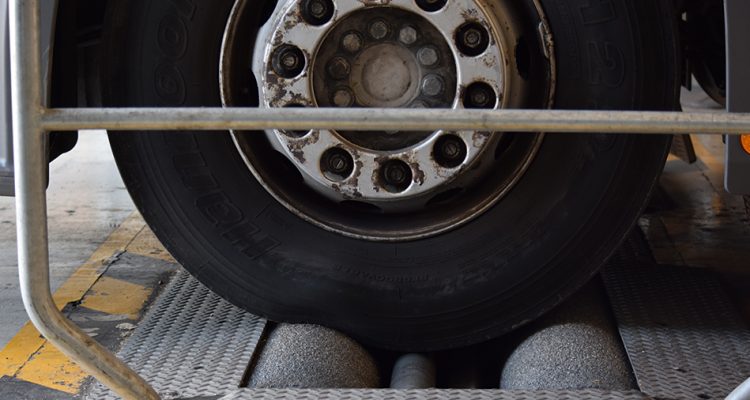For every vehicle you manage, your brake test report can tell you more than whether the vehicle has passed or failed a test. So, you need to give it a good read through – and understand what it’s telling you.
The report can tell you if it has met various overall efficiencies such as that for service, secondary and park. But it also tells you what you might need to investigate further.
The report can identify individual braking aspects where extra action is needed to avoid further problems that could result in brake failure. This includes bind, time lag, ovality, imbalance and maximum force. Vehicle details and weight imposed on each axle is shown on each report too.
If a report shows a brake balance across an axle only just passes, what would you do? Would you know how to find out what was causing the problem?
You should file the report as a part of your maintenance system and any investigation or repairs should be recorded.
A key part of your maintenance system
The brakes are one the most important safety systems in your vehicle and should be a key part of the maintenance system.
The braking performance needs checking at every safety inspection. This means they must be monitored and correctly maintained to optimise their efficiency.
Poorly maintained brakes may result in the loss of control of a vehicle with dire consequences.
 Understanding the brake test report
Understanding the brake test report
Operators should always look at their report after the test, regardless of the result.
So, even if the brake test shows a pass, you need to look at it to identify items that may be getting worse and need dealing with before they let you down.
And for that you need to understand it.
DVSA has published some guidance to help you better understand brake testing reports.
The industry body, Logistics UK has also produced some guidance on this subject for members.
Review every brake test report before putting it away and carry out any investigation or repair work as necessary. Make sure the work is done correctly and recorded in the maintenance file. And make it available at the next inspection, so the technician can refer to it to check to see if has deteriorated.
Remember, a pass result does not always mean there is no action to take.
You or your transport manager/maintenance provider may need to review the report to determine how to improve the vehicle’s braking.
The ‘other key headlines’ section shows the way in which your fleet is maintained and how your business is conducted.
The key questions to ask
Here are some of the things you should be reviewing when you get your brake test reports.
This list isn’t exhaustive but offers a helpful starting point:
- are the figures in the report as high as expected? Compare them with sister trucks and/or trailers in the fleet
- is one vehicle performing differently from a sister vehicle in your fleet?
- were the vehicles loaded in a similar way and tested in the same manner?
- does the vehicle have the same type of brakes, is it maintained differently or at another location?
- are there any differences that could be a cause for investigation? If so, record your investigation and any repairs made to the vehicle
- are drivers reporting any braking issues, or were any common faults identified and subsequently repaired by the maintenance provider(s)?
A few examples
Possible braking defects
If axle 2 service brake on the offside shows an imbalance of 26% (offside wheel does not lock) when compared to the nearside brake effort, this indicates a possible braking defect so you would need to investigate further.
Offside brake issue
Axle 3 imbalance at 29% with no wheels locking. Although this does not exceed the limit of 30%, it indicates that there is an issue with the offside brake which requires investigation.
Vehicles with split brake systems that the manufacturer has designated as the secondary brake are not assessed as part of the brake inspection. But the brake report may show efficiency readings for these (failures for these can be ignored but this may be reflected in the service braking aspect so you would need to look into this).
How park brake efficiencies are tested
The park brake efficiencies could be tested against the design gross vehicle weight (16%) or the design gross train weight (12%). This is because motor vehicle park brake efficiency should meet the efficiency for whichever is the higher figure.
It’s worth saying that testing equipment such as roller brake testers must be maintained and calibrated to ensure the readings are accurate.
To conclude, brakes are a critical part of your vehicle, so you can’t afford to leave them without investigation when something is mentioned in the brake testing report.
Looking after the brakes will help you keep your vehicles safe to drive.
A note on slack adjusters
We’ve recently updated our guide to maintaining slack adjusters. These are a feature of brakes which make sure brakes continue to work well, even as the lining wears down.
The main issue we see frequently is where automatic slack adjusters are manually adjusted at service because they are not automatically adjusting correctly.
It’s common to read “adjust brakes” on multiple safety inspections (SIs) and then eventually the automatic slack adjuster may get replaced.
Manually adjusting the automatic slack adjuster does not fix the problem and can damage the mechanism. The correct way to maintain and check the automatic slack adjuster is covered in our updated guidance.
Author: Richard Clements



















